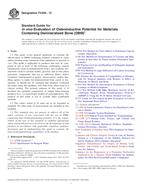We need your consent to use the individual data so that you can see information about your interests, among other things. Click "OK" to give your consent.
ASTM E1440-91(2012)
Standard Guide for Acute Toxicity Test with the Rotifer Brachionus (Withdrawn 2021)
Automatically translated name:
Standard Guide for Acute Toxicity Test with the Rotifer BrachionusSTANDARD published on 1.12.2012
The information about the standard:
Designation standards: ASTM E1440-91(2012)
Note: WITHDRAWN
Publication date standards: 1.12.2012
SKU: NS-41765
The number of pages: 8
Approximate weight : 24 g (0.05 lbs)
Country: American technical standard
Category: Technical standards ASTM
The category - similar standards:
Annotation of standard text ASTM E1440-91(2012) :
Keywords:
acute toxicity, cysts, freshwater, invertebrate, LC50, marine, rotifers, toxicity test, ICS Number Code 11.100.99 (Other standards related to laboratory medicine)
Additional information
| Significance and Use | ||||||||||||||||||||||||||||||||||
|
5.1 An important goal of aquatic toxicology is to determine the effects of toxic compounds on species that play a central role in aquatic communities. Rotifers have a major impact on several important ecological processes in freshwater and coastal marine environments. As filter-feeders on phytoplankton and bacteria, rotifers exert substantial grazing pressure that at times exceeds that of the larger crustacean zooplankton 5.2 In addition to their important ecological role in aquatic communities, rotifers are attractive organisms for toxicological studies because an extensive database exists on the basic biology of this group. Techniques have been published for the culture of many rotifer species (3, 19). The rotifer life cycle is well defined 5.3 Toxicity tests with rotifers of the genus Brachionus are more easily performed than with many other aquatic animals because of their rapid reproduction, short generation times, sensitivity 5.4 The test described here is fast, easy to execute, sensitive, and cost-effective. Obtaining test animals from cysts greatly reduces some of the major problems in routine aquatic toxicological testing such as the limited availability of test animals and the inconsistency of sensitivity over time. Rotifers hatched from cysts are of similar age and are physiologically uniform, thus eliminating pre-test conditions as a source of variability in the toxicity test. Cysts can be shipped inexpensively world-wide, allowing all laboratories to use standard, genetically defined strains that have been calibrated with reference toxicants. The convenience of an off-the-shelf source of test animals that require no pre-conditioning is likely to permit new applications of aquatic toxicity tests. 5.5 Sensitivity to toxicants is compound and species specific, but the sensitivity of B. calyciflorus is generally comparable to that of Daphnia (37). 5.6 Rotifer cysts are commercially available, but they can also be obtained from natural populations and from laboratory cultures. Techniques for rotifer cyst production in laboratory populations have been described 1.1 This guide describes procedures for obtaining laboratory data concerning the acute toxicity of chemicals and aqueous effluents released into fresh, estuarine, or marine waters. Acute toxicity is measured by exposing Brachionus newly hatched from cysts to a series of toxicant concentrations under controlled conditions. This guide describes a test for using 1.2 Modifications of these procedures might be justified by special needs or circumstances. Although using appropriate procedures is more important than following prescribed procedures, the results of tests conducted using modified procedures might not be comparable to rotifer acute tests that follow the protocol described here. Comparison of the results using modified procedures might provide useful information concerning new concepts and procedures for conducting acute toxicity tests on chemicals and aqueous effluents. 1.3 This guide is organized as follows:
1.4 These procedures are applicable to most chemicals, either individually or in formulations, commercial products, or mixtures. This guide can also be used to conduct investigations of the effects on rotifer survival of pH, hardness, and salinity and on materials such as aqueous effluents, leachates, oils, particulate matter, sediments, and surface waters. This guide might not be appropriate for materials with high oxygen demand, with high volatility, subject to rapid biological or chemical transformation, or that readily sorb to test chambers. 1.5 This standard does not purport to address all of the safety concerns, if any, associated with its use. It is the responsibility of the user of this standard to establish appropriate safety and health practices and determine the applicability of regulatory limitations prior to use. | ||||||||||||||||||||||||||||||||||
|
Standard Guide for Conducting Acute Toxicity Tests on Test Materials with Fishes, Macroinvertebrates, and Amphibians (Includes all amendments and changes 2/22/2023). |
||||||||||||||||||||||||||||||||||
|
Standard Practice for Use of the Internation System of Units (SI) (the Modernized Metric System) (Withdrawn 1997) |
||||||||||||||||||||||||||||||||||
|
Standard Guide for Conducting Acute Toxicity Tests on Aqueous Ambient Samples and Effluents with Fishes, Macroinvertebrates, and Amphibians |
||||||||||||||||||||||||||||||||||
|
Standard Terminology Relating to Biological Effects and Environmental Fate |
||||||||||||||||||||||||||||||||||
Similar standards:
Historical
1.9.2010
Historical
1.3.2011
Historical
1.10.2013
Historical
1.3.2011
Historical
1.3.2012
Historical
1.2.2013
We recommend:
Technical standards updating
Do you want to make sure you use only the valid technical standards?
We can offer you a solution which will provide you a monthly overview concerning the updating of standards which you use.
Would you like to know more? Look at this page.



 ASTM E1380-90(2010)..
ASTM E1380-90(2010).. ASTM F2103-11
ASTM F2103-11 ASTM F2211-13
ASTM F2211-13 ASTM F2383-11
ASTM F2383-11 ASTM F2459-12
ASTM F2459-12 ASTM F2529-13
ASTM F2529-13
 Cookies
Cookies
